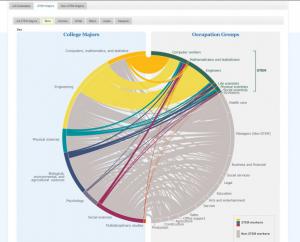Why do Women Hold Just 24% of STEM Jobs in the U.S.A.?
Women earn 3 out of 10 undergraduate STEM degrees and hold fewer than 1 in 4 jobs in STEM professions.Read why gender inequality exists in STEM-related careers.
NEW INTERACTIVE CHARTS FROM THE U.S. CENSUS MAKE IT EASY TO VISUALIZE WOMEN IN STEM STATISTICS
Thanks to some very elegant charts created by the U.S. Census Bureau, it’s easier than ever to understand the relationships between undergraduate degrees obtained by men and women and the type of occupations they pursue in their careers. This quick video gives you a clear idea of how these interactive charts work:
Where Do College Graduates Work
Now let’s take a closer look at these interactive charts. (You can find them here on the U.S. Census Website.)
Female STEM Major Graduates and their Corresponding Careers
In the static screenshot above, we selected Women graduates with STEM degrees; their top college majors are Social Sciences, followed by Psychology, and then by a group consisting of majors in the fields of Biological, Environmental, and Agricultural Sciences.
(Tip: to see the numerical data in Excel format, visit the live chart on the U.S. Census web page and use the link found below the live chart.)
Now let’s change our criteria by selecting Men with STEM Majors.
Male STEM Major Graduates and their Corresponding Careers
Once you set the criteria to men holding a STEM degree, what jumps out at you is the large upside-down yellow arc that connects engineering majors on the left to engineering careers on the right. This arc represents the large pipeline of male engineering graduates who take engineering jobs.
While around half of these male graduates end up working in non-STEM careers (as indicated by the grayed-out lines), men still far outnumber women in obtaining both engineering degrees and engineering jobs. (Indeed, women hold only 14% of engineering positions, according to the Census Bureau.)
WHY AREN’T THERE MORE WOMEN WORKING IN STEM OCCUPATIONS?
When it comes to understanding why the number of women in STEM occupations falls short, particularly in the fields of engineering and computer science, the charts above give us one important clue: the pipeline for STEM undergraduates is skewed toward men.
That means to achieve greater equality in the workplace, it will be necessary to recruit more women to pursue STEM degrees — as well as ensuring these women graduates actually make it all the way to being hired in a STEM career. (As you can see from the charts above, quite a few women with STEM degrees are electing to pursue careers in non-STEM fields, such as healthcare.)
More and more programs are now encouraging and mentoring young girls to learn about the possibility of pursuing successful and rewarding STEM careers — ranging from the Girl Scouts (who recently introduced a STEM Merit Badge) to numerous summer camp programs designed to teach young girls how to code.
Tip: STEMConnector is a useful website for finding news about STEM initiatives and resources in your area of the country.
OVERCOMING BIASES AGAINST WOMEN IN STEM
Efforts that encourage women to pursue careers in STEM fields haven’t been able to erase some of the long-standing stereotypes and biases facing women who choose to pursue work in high-tech careers.
For example, a recent study at the University of Colorado at Boulder identified a pattern of bias against women who have longer hair or finer facial features — just by looking at photos, a large number of study participants tended to incorrectly assume that those women in the photographs were primary school teachers rather than scientists.
Other biases that women working in STEM can encounter include what’s now commonly known as “Mansplaining” and its related condition, “He-Peating.”
Video of a Virtual Reality Training Session which Illustrates a Real World Example of Mansplaining in an Office Meeting
If you are not up to speed on the current terminology, mansplaining is the unfortunate but very real tendency of certain men to provide unnecessarily condescending explanations to female colleagues. He-peating refers to situations where a man repeats an idea or suggestion made by a woman, such as during a meeting. While the woman’s original suggestion was ignored or dismissed, the group embraces the idea when it’s repeated by a man, who gladly takes credit for the idea.
Women who are (or plan to be) parents also face discrimination in the job hiring and promotions process that their male colleagues do not. In order to better understand how and why this happens, Stanford University Sociology Professor Shelley J. Correll conducted a study where two identically qualified candidates were presented to test subjects taking on the role of “hiring managers.” After the hiring managers selected two equally qualified candidates from a pool of applicants, researchers alerted them that one of the candidates was, in fact, a parent. In the study, the hiring managers didn’t change their opinion about the candidate if he was a male parent. However, if the job candidate was female, the hiring managers preferred to select the other, non-parent candidate — and they were only willing to consider hiring the female parent candidate when the starting salary was reduced by an average of $11,000.
Despite the biases against working mothers, many women continue to pursue a professional career. However, quite a few also decide to voluntarily exit the career track as they reach their late 30s and 40s (an age which would be considered ‘mid-career’ amongst men). Researcher Pamela Stone has investigated this “mommy track” phenomenon and has dispelled many of the myths commonly associated with professional women electing to “opt out” of the workforce well before retirement age. From Stone’s analysis, it’s clear that much work needs to be done to achieve a greater life/work balance in the workplace, including making part-time work and job sharing a more socially acceptable practice, so that so that women can pursue fulfilling, life-long professional careers.
Finally, we must address the issue of sexual harassment and sexual assault in the workplace. During the past year, the growing “#MeToo” movement has shone a light on shocking, high-profile cases of men in politics and media who have used their positions of power and influence to sexually harass and abuse women. As more and more women have come forward to tell their stories, one can only hope that we, as a society, can work together to build a more honorable and respectful environment for women in the workplace.
WHY WE NEED MORE WOMEN IN STEM OCCUPATIONS
Take a look at the chart below which illustrates the changing nature of the STEM job market since 1970. (Source: U.S. Census)
As you can see, the top two STEM careers (as ranked by the number of positions in the job market) are engineering and computing. Both of these careers are prestigious, well paid (the median annual income of engineering jobs is $92,900), and offer lots of opportunities for growth and advancement. The number of computing jobs is growing the fastest; it became the largest STEM job category just before the year 2000.
Yet, despite the high salaries and prestige associated with these careers, these are the very STEM fields where participation by women is particularly low. For women to enjoy the same economic opportunities and prestige status as men, it’s important that they are given an equal shot at these STEM career opportunities.
But what if you don’t believe in the need for equal opportunity as a stand-alone goal? Are there other reasons you might want more women to work in STEM occupations?
One important reason we need more women in STEM fields is to tackle the overall shortage of talented, high-tech workers, an issue that is projected to become direr as an ever-increasing number of Baby Boomer workers retire. Excluding half of the potential candidates just doesn’t make any sense.
Many businesses believe that a diverse workplace also leads to better decisions, and ultimately, higher profits. According to survey results published in a Peterson Institute for International Economics working paper, companies with 30% or more women in C-Suite leadership roles are more profitable, earning up to 15% higher net income on average.
Ethics might provide another important reason. Researchers Kennedy and Kray studied the behavior of both men and women in two different scenarios; one using workers recruited by Amazon’s Mechanical Turk Service, and another using male and female college students. In both cases, women were more likely to flag ethically questionable decisions. For those companies who have been found guilty of putting profit ahead of principles, such as the Volkswagen Group (whose engineers sought to defeat smog testing devices with illegal software), having more women engineers and computer scientists on staff might have helped them avoid the damage to their employers’ reputation, as well as massive fines and now jail sentences being meted out to their male colleagues.
We’re curious to hear your point of view.
Read more ... https://formaspace.com/articles/uncategorized/need-more-women-in-stem-jobs/?utm_source=einpresswire&utm_medium=social&utm_campaign=article-121217
Brooke Turner
Formaspace
8002511505
email us here
Legal Disclaimer:
EIN Presswire provides this news content "as is" without warranty of any kind. We do not accept any responsibility or liability for the accuracy, content, images, videos, licenses, completeness, legality, or reliability of the information contained in this article. If you have any complaints or copyright issues related to this article, kindly contact the author above.




